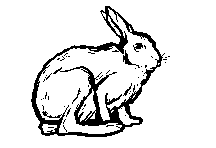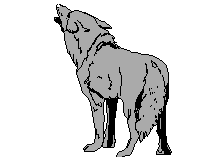|
|
| |
| CHAPTER 4: Introduction to Systems Theory |
| |
(e). Food Chain as an Example of a System
|
|
A food
chain models the movement of energy in
an ecosystem (a form of environmental
system). Figure 4e-1 below illustrates the
movement of energy in a typical food chain. In this
diagram, we begin the food chain with 100,000 units
of light energy from the Sun.
Note, the amount of energy available at each successive
level (called trophic levels) of this system becomes
progressively less. Only 10 units of energy are available
at the last level (carnivores)
of the food chain. A number of factors limit the assimilation of
energy from one level to the next. We will examine
these factors later in this textbook.
 |
The
Sun is the
original source of energy, in the form of light,
for the food chain.
(100,000 Units of Energy) |
 |
Plants capture
approximately 1% of the available light energy
from the Sun for biomass production by way of
photosynthesis. Photosynthesis can be described
chemically as: Light Energy + 6CO2 +
6H2O
==> C6H12O6 +
6O2
(1,000 Units of Energy) |
 |
Herbivores consume
approximately 10% of the plant biomass produced
in a typical food chain.
(100 Units of Energy) |
 |
Carnivores capture
and consume about 10% of the energy stored by
the herbivores.
(10 Units of Energy) |
| Figure 4e-1: Model
of the grazing food chain showing the movement
of energy through an ecosystem. |
Why is the above illustration an example
of a system?
The concept of what makes something a system was fully
explained in section 4b.
In this topic, it was suggested that all systems share
the following seven common characteristics:
- Systems have a structure that
is defined by its parts and processes.
In the above example, the structure consists of the
system's three types of properties. This system has
the following elements:
the Sun, plants, herbivores and carnivores.
Within this system the main characteristic, or attribute,
of the elements being perceived is units of energy.
The last component that makes up the structure of
this system is the cause and effect relationships
between the elements and attributes. For example,
the Sun creates energy via nuclear fusion. This energy
is radiated from the Sun's surface and received by the surface
of the Earth. On the surface of the Earth plants
capture some of this solar radiation in the chloroplasts
that exist in their tissues. Through photosynthesis the
plants convert the radiant energy into energy rich
organic matter. Some of the energy fixed by the plants
is passed on to herbivores through consumption. Finally,
a portion of the energy assimilated by
the herbivores is then passed on to carnivores through
consumption.
- Systems are generalizations of reality.
The food chain process described above is a simple
abstraction of what actually happens in a variety
of different types of terrestrial ecosystems of much
greater complexity.
- Systems tend to function in
the same way. All systems
consist of groups of parts that interact with each
other according to various cause and effect processes.
In the food chain model, the parts are the Sun, plants, herbivores and carnivores.
There are two main processes taking place in this
system. The first involves the movement of energy,
in the form of radiation, from the Sun to the plants.
The second process involves the movement of energy,
in the form of organic molecules, from plants to
herbivores, and then finally to carnivores through
biomass consumption.
- The various parts of a system have functional as
well as structural relationships between
each other. The structure within the food
chain is defined by the functional relationships
between the elements and attributes of the system.
- The fact that functional relationships
exist between the parts suggests the flow and transfer of
some type of energy or matter. Systems
exchange energy and matter internally and with
their surrounding environment through various processes
of input and output.
The main material being transferred into this system
(input) is energy in the form of solar
radiation. The solar radiation is then fixed
into organic matter (output) by
way of photosynthesis in
the plants. Herbivores consume
the constructed plant organic molecules for nutrition
to run their metabolism. The herbivores then provide
food for the carnivores.
- Systems often exchange energy and/or
matter beyond their defined boundary with the outside
environment, and other systems, through various input and output processes.
The organisms found in a food chains transfer
organic matter into the detritus food
chain when they shed tissues or die. This transfer
represents a net output of matter out of the food
chain. With decomposition, the organic matter is
converted into inorganic nutrients which can be
taken up by plants in the food chain to produce
new organic matter. This transfer represents a
net input of matter into the food chain system.
- Functional relationships can only
occur because of the presence of a driving
force. The
driving force in the food chain is the Sun.
- The parts that make up a system
show some degree of integration -
in other words the parts work well together. Integration
in the food chain comes primarily from the process
of evolution. It was through evolution that plants,
herbivores, and carnivores came about and developed
ecological associations between each other.
|
| |
Study Guide |
| |
Additional Readings |
| |
| Internet
Weblinks |
| |
| Citation: Pidwirny,
M. (2006). "Food Chain as an Example of a System". Fundamentals of Physical Geography,
2nd Edition. Date
Viewed. http://www.physicalgeography.net/fundamentals/4e.html |
| |
|
|






